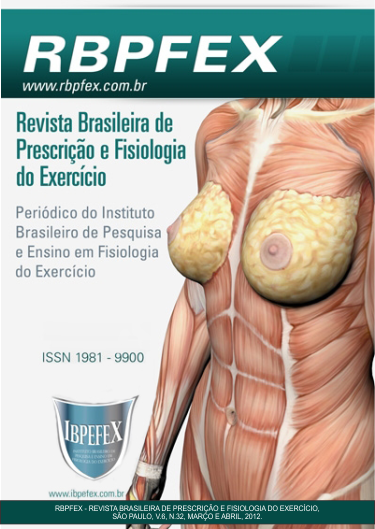Número de repetições e percentual de carga máxima: comparação entre exercícios uni e multiarticular
Resumo
O objetivo deste estudo foi comparar o número de repetições alcançadas a 80% de 1RM entre exercícios uni e multiarticular para o peitoral e comparar o número de repetições alcançadas com o número previsto pela literatura para a intensidade de 80% de 1RM. Foram selecionados 10 homens idade (22,3±2,6; peso 74,9±11,1; altura 176,9±4,9 ), praticantes de treinamento resistido, que realizaram uma série máxima com 80% de 1RM até a fadiga concêntrica. Os exercícios utilizados foram o voador e o supino horizontal. O número de repetições alcançado no voador (10,4±2,0) foi maior que no supino horizontal (8,3±2,3), porém não foi encontrada diferença significativa. Ao comparar as repetições dos exercícios com o número de repetições previsto pela literatura, o voador apresentou um número de repetições significativamente maior. Logo, a determinação da intensidade do exercício através do percentual de 1RM não deve ser utilizada na prescrição do treinamento de força.
Referências
-American College of Sports Medicine. Position stand on quantity and quality of exercise for developing and maintaining cardiorespiratory, musculoskeletal, and neuromotor fitness inapparently healthy adults: guidance for prescribing exercise. Medicine and Science in Sports and Exercise. Vol. 43. Num. 7. 2011. p. 1334-1359.
-American College of Sports Medicine. Position stand on progression models in resistance training for healthy adults. Medicine and Science in Sports and Exercise. Vol. 41. Num. 3. 2009. p. 687-708.
-Baechle, T.R.; Earle, R.W. Fundamentos do treinamento de força e do condicionamento. 3ª ed. Barueri, SP: Manole, 2010.
-Berger, R. Effect of varied weight training programs on strength. The Research Quarterly. Vol. 33. Num. 2. 1962a. p. 168-181.
-Berger, R. Optimum repetitions for the development of strength. The Research Quarterly. Vol. 33. Num. 3. 1962b. p. 334-338.
-Campos, G.E.R.; Luecke, T.J.; Wendeln, H.K.; Toma, K.; Hagerman, F.C.; Murray, T.F.; Ragg, K.E.; Ratames, N.A.; Kraemer, W.J.; Staron, R.S. Muscular adaptations in response to three different resistance-training regimes: specificity of repetition maximum training zones. European Journal of Applied Physiology. Vol. 88. Num. 1-2. 2002. p. 50-60.
-Chagas, M.H.; Barbosa, J.R.M.; Lima, F.V. Comparação do número máximo de repetições realizadas a 40 e 80% de uma repetição máxima em dois diferentes exercícios na musculação entre os gêneros masculino e feminino. Revista Brasileira de Educação Física e Esporte. Vol. 19. Num. 1. 2005. p. 5-12.
-Dias, I.; Salles, B.F.; Novaes, J.; Costa, P.B.; Simão, R. Influence of exercise order on maximum strength in untrained young men. Journal of Science and Medicine in Sport. Vol. 13. Num. 1. 2010. p. 65-69.
-Fleck, SJ, Kraemer, WJ. Designing Resistance Training Programs. 3ª edição. Campaign: Human Kinetics, 2004.
-Hoeger, W.; Barette, S.L.; Hale, D.F.; Hopkins, D.R. Relationship between repetitions and selected percentages of one repetition maximum. Journal of Applied Sport Science Research. Vol. 1. Num. 1. 1987. p. 11-13.
-Hoeger, W.; Hopkins, D.R.; Barette, S.L.; Hale, D.F. Relationship between repetitions and selected percentages of one repetition maximum: A comparison between untrained and trained males and females. Journal of Applied Sport Science Research Vol. 4. Num. 2. 1990. p. 47-54.
-Kraemer, W.J.; Ratamess, N.A. Fundamentals of resistance training: progression and exercise prescription. Medicine and Science in Sports and Exercise. Vol. 36. Num. 4. 2004. p. 674-688.
-Maior, A.S.; Simão, R. Prescrição de exercícios através do teste de 1RM em homens. Revista Treinamento Desportivo. Vol. 7. Num. 1. 2006. p. 82-86.
-Pick, J.; Becque, M.D. The relationship between training status and intensity on muscle activation and relative submaximal lifting capacity during the back squat. Journal of Strength and Conditioning Research. Vol. 14. Num. 2. 2000. p. 175-181.
-Shephard, R.J. PAR-Q, Canadian home fitness test and exercise screening alternatives. Sports Medicine. Vol. 5. Num. 3. 1988. p. 185-195.
-Shimano, T.; Kraemer, W.J.; Spiering, B.A.; Volek, J.S.; Hatfield, D.L.; Silvestre, R.; Vingren, J.L.; Fragala, M.S.; Maresh, C.M.; Fleck, S.J.; Newton, R.U.; Spreuwenberg, L.P.B.; Hakkinen, K. Relationship between the number of repetitions and selected percentages o fone repetition maximum in free weight exercises in trained and untrained men. Journal of Strength and Conditioning Research. Vol. 20. Num. 4. 2006. p. 819-823.
-Simão, R.; Poly, M.A.; Lemos, A. Prescrição de exercícios através do teste de uma repetição máxima (T1RM) em homens treinados. Fitness e Performance Journal. Vol. 3. Num. 1. 2004. p. 47-52.
-Simão, R.; Farinatti, P.T.; Polito, M.D.; Viveiros, L.; Fleck, S.J. Influence of exercise order on the number of repetitions performed and perceived exertion during resistance exercise in women. Journal of Strength and Conditioning Research. Vol. 21. Num. 1. 2007. p. 23-28.
-Simão, R.; Spineti, J.; de Salles, B.F.; Matta, T.; Fernandes, L.; Fleck, S.J.; Rhea, M.R.; Strom-Olsen, H.E. Comparison between nonlinear and linear periodized resistance training: hypertrophic and strength effects. Journal of Strength and ConditioningResearch. In Press. 2012.
-Tan, B. Manipulating resistance training program variables to optimize maximum strength in men: a review. Journal of Strength and Conditioning Research. Vol. 13. Num. 3. 1999. p. 289-304.
Autores que publicam neste periódico concordam com os seguintes termos:
- Autores mantém os direitos autorais e concedem ao periódico o direito de primeira publicação, com o trabalho simultaneamente licenciado sob a Creative Commons Attribution License BY-NC que permitindo o compartilhamento do trabalho com reconhecimento da autoria do trabalho e publicação inicial neste periódico.
- Autores têm autorização para assumir contratos adicionais separadamente, para distribuição não-exclusiva da versão do trabalho publicada neste periódico (ex.: publicar em repositório institucional ou como capítulo de livro), com reconhecimento de autoria e publicação inicial neste periódico.
- Autores têm permissão e são estimulados a publicar e distribuir seu trabalho online (ex.: em repositórios institucionais ou na sua página pessoal) a qualquer ponto antes ou durante o processo editorial, já que isso pode gerar alterações produtivas, bem como aumentar o impacto e a citação do trabalho publicado (Veja O Efeito do Acesso Livre).






